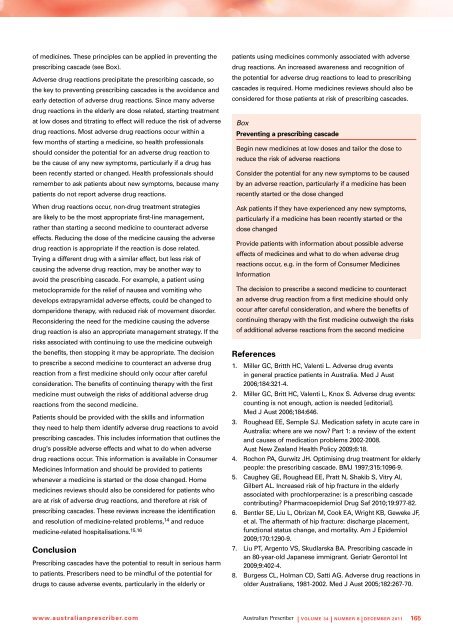PDF version - Australian Prescriber
PDF version - Australian Prescriber
PDF version - Australian Prescriber
Create successful ePaper yourself
Turn your PDF publications into a flip-book with our unique Google optimized e-Paper software.
of medicines. These principles can be applied in preventing theprescribing cascade (see Box).Adverse drug reactions precipitate the prescribing cascade, sothe key to preventing prescribing cascades is the avoidance andearly detection of adverse drug reactions. Since many adversedrug reactions in the elderly are dose related, starting treatmentat low doses and titrating to effect will reduce the risk of adversedrug reactions. Most adverse drug reactions occur within afew months of starting a medicine, so health professionalsshould consider the potential for an adverse drug reaction tobe the cause of any new symptoms, particularly if a drug hasbeen recently started or changed. Health professionals shouldremember to ask patients about new symptoms, because manypatients do not report adverse drug reactions.When drug reactions occur, non-drug treatment strategiesare likely to be the most appropriate first-line management,rather than starting a second medicine to counteract adverseeffects. Reducing the dose of the medicine causing the adversedrug reaction is appropriate if the reaction is dose related.Trying a different drug with a similar effect, but less risk ofcausing the adverse drug reaction, may be another way toavoid the prescribing cascade. For example, a patient usingmetoclopramide for the relief of nausea and vomiting whodevelops extrapyramidal adverse effects, could be changed todomperidone therapy, with reduced risk of movement disorder.Reconsidering the need for the medicine causing the adversedrug reaction is also an appropriate management strategy. If therisks associated with continuing to use the medicine outweighthe benefits, then stopping it may be appropriate. The decisionto prescribe a second medicine to counteract an adverse drugreaction from a first medicine should only occur after carefulconsideration. The benefits of continuing therapy with the firstmedicine must outweigh the risks of additional adverse drugreactions from the second medicine.Patients should be provided with the skills and informationthey need to help them identify adverse drug reactions to avoidprescribing cascades. This includes information that outlines thedrug's possible adverse effects and what to do when adversedrug reactions occur. This information is available in ConsumerMedicines Information and should be provided to patientswhenever a medicine is started or the dose changed. Homemedicines reviews should also be considered for patients whoare at risk of adverse drug reactions, and therefore at risk ofprescribing cascades. These reviews increase the identificationand resolution of medicine-related problems, 14 and reducemedicine-related hospitalisations. 15,16ConclusionPrescribing cascades have the potential to result in serious harmto patients. <strong>Prescriber</strong>s need to be mindful of the potential fordrugs to cause adverse events, particularly in the elderly orpatients using medicines commonly associated with adversedrug reactions. An increased awareness and recognition ofthe potential for adverse drug reactions to lead to prescribingcascades is required. Home medicines reviews should also beconsidered for those patients at risk of prescribing cascades.BoxPreventing a prescribing cascadeBegin new medicines at low doses and tailor the dose toreduce the risk of adverse reactionsConsider the potential for any new symptoms to be causedby an adverse reaction, particularly if a medicine has beenrecently started or the dose changedAsk patients if they have experienced any new symptoms,particularly if a medicine has been recently started or thedose changedProvide patients with information about possible adverseeffects of medicines and what to do when adverse drugreactions occur, e.g. in the form of Consumer MedicinesInformationThe decision to prescribe a second medicine to counteractan adverse drug reaction from a first medicine should onlyoccur after careful consideration, and where the benefits ofcontinuing therapy with the first medicine outweigh the risksof additional adverse reactions from the second medicineReferences1. Miller GC, Britth HC, Valenti L. Adverse drug eventsin general practice patients in Australia. Med J Aust2006;184:321-4.2. Miller GC, Britt HC, Valenti L, Knox S. Adverse drug events:counting is not enough, action is needed [editorial].Med J Aust 2006;184:646.3. Roughead EE, Semple SJ. Medication safety in acute care inAustralia: where are we now? Part 1: a review of the extentand causes of medication problems 2002-2008.Aust New Zealand Health Policy 2009;6:18.4. Rochon PA, Gurwitz JH. Optimising drug treatment for elderlypeople: the prescribing cascade. BMJ 1997;315:1096-9.5. Caughey GE, Roughead EE, Pratt N, Shakib S, Vitry AI,Gilbert AL. Increased risk of hip fracture in the elderlyassociated with prochlorperazine: is a prescribing cascadecontributing? Pharmacoepidemiol Drug Saf 2010;19:977-82.6. Bentler SE, Liu L, Obrizan M, Cook EA, Wright KB, Geweke JF,et al. The aftermath of hip fracture: discharge placement,functional status change, and mortality. Am J Epidemiol2009;170:1290-9.7. Liu PT, Argento VS, Skudlarska BA. Prescribing cascade inan 80-year-old Japanese immigrant. Geriatr Gerontol Int2009;9:402-4.8. Burgess CL, Holman CD, Satti AG. Adverse drug reactions inolder <strong>Australian</strong>s, 1981-2002. Med J Aust 2005;182:267-70.www.australianprescriber.com| Volume 34 | NUMBER 6 | decemBER 2011 165
















